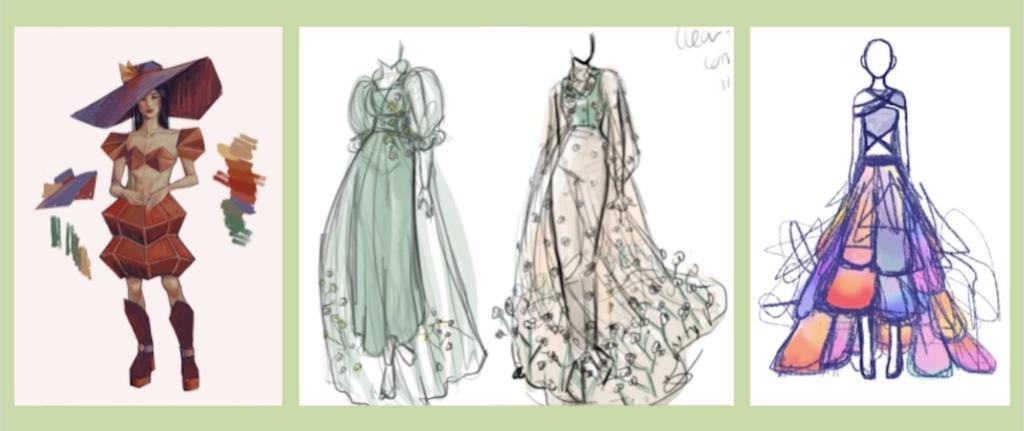Lights flash and shutters click wildly as celebrities walk the stairs of The Metropolitan Museum of Art, showing off extravagant haute couture pieces. The Met Gala is highly regarded as the biggest event in fashion, garnering the attention and attendance of the world’s biggest celebrities. Rather than being held on the famed “first Monday of May,” the event was held on Sept. 13 due to the pandemic.
This year’s theme was “In America: A Lexicon of Fashion”, with poet and activist Amanda Gorman, actor Timothée Chalamet, tennis star Naomi Osaka and singer Billie Eilish as co-chairs. While many people were initially confused about what the American fashion theme entails, celebrities interpreted the theme in innovative ways, such as celebrating individuality, referencing old Hollywood and western aesthetics or making political statements.
Junior Milena Rodriguez said she thinks the American fashion theme was a way to promote the often overlooked impact of American designers on the fashion industry.
“I remember when they announced the theme people were really upset because they’re like ‘America doesn’t have fashion,’” Rodriguez said. “I do think people forget that a lot of the creative directors for brands like Louis Vuitton or Gucci are American designers.”
Many celebrities chose to embody the style of vintage cinema with their looks. Some, including senior Jasmine Kapadia, were quite disappointed with how this theme was executed.
“They sort of took black and white aspects and did their hair and the curls and just left it at that,” Kapadia said. “It’s the Met Gala, I would have expected them to take it another step further.”
The addition of social media influencers such as Emma Chamberlain, Addison Rae and Dixie D’Amelio to the gala’s guest list was also controversial.
“I think Anna Wintour [Vogue editor-in-chief who curates the gala’s guest list] especially has always been wanting to push internet culture,” Kapadia said.
Inspired by this year’s Met Gala theme, we asked three Palo Alto High School artists to create a visual foray into their definition of America and American fashion and design their very own hypothetical Met Gala look for Verde.
“The Met Gala every year is always sort of a lesson in how to be extreme and the places that fashion can take us as self-expression,” Kapadia said.
Jasmine Kapadia: The modern-era cowboy
Senior Jasmine Kapadia said she wanted to explore the theme of Americana and western aesthetics.
Kapadia went for a dramatic silhouette, with a large hat and cowboy-inspired platform boots. Kapadia said she drew inspiration from current trends and modern geometric techniques to make the look eye-caching and memorable.
“The cowboy represents an element of America that’s almost a bit sort of folklore-y, sort of shrouded in fantasy.”
— Jasmine Kapadia, senior
“For a Met Gala look, you always want to have one thing that people can emulate or that would ‘go viral,’” Kapadia said.
Kapadia said she was inspired by the idea of cowboys representing American freedom, and wanted to emulate warm saturated tones as though the viewer is riding off into the sunset.
“The cowboy represents an element of America that’s almost a bit sort of folklore-y, sort of shrouded in fantasy,” Kapadia said. “It’s this idea of freedom and just really not being tied down to anything, so I really wanted to take that and conceptualize it.”
Savannah Voth: An homage to the American imagination
Senior Savannah Voth said she examined the intersection of traditional and modern fashion, incorporating elements of her own American identity into her designs.
“As I was looking through the exhibition associated with this year’s theme, I found myself really inspired by the historical lens and looking at American fashion of the past and how it’s evolved and influenced fashion today.”
Voth said she paid homage to the classic paintings of the American landscape in her creations.
“I also included floral motifs in all of my designs as a nod to the American landscape, which is a major aspect of the American imagination,” Voth said. “I based them off of native plants in this area to create that sense of place.”
“As I was looking through the exhibition associated with this year’s theme, I found myself really inspired by the historical lens and looking at American fashion of the past and how it’s evolved and influenced fashion today.”
— Savannah Voth, senior
Voth’s main inspiration behind her work was dolls her mother made for her when she was Voth’s age. Voth’s mother immigrated to the United States from Japan at a young age and was often treated as an outsider.
“She made these dolls out of t-shirt fabric and fabric scraps, and essentially reinterpreted traditional American fashion, and made it uniquely her own,” Voth said.
Additionally, Voth said she reflected her own Asian-American identity in her designs.
“I wanted to include elements of traditional Asian clothing and design into these outfits … to explore how different cultural identities all exist and relate to one another and influence one another,” Voth said.
Caroline Zhang: Colorful melting pot
Junior Caroline Zhang said she worked to create a dress that exemplifies the sociocultural characteristics of America.
Her design consists of a long, flowy dress with vibrant multicolored layers patched together.
“Since the very start of America’s founding, it has always been very diverse and multicultural,” Zhang said. “I wanted to show all the colors coming together to represent different people coming together and making America what it is today.”
Although she said she values the diversity of the United States, Zhang recognizes the inequalities still present in society today. To illustrate the holes in American culture, she included cutouts at the top of her dress.
“America still has a lot of difficulties and barriers of equality to overcome between these groups of people,” Zhang said. “At the very top of the dress, where there are gaps and holes in it, it shows that there is still more work to be done.”



